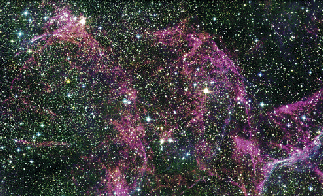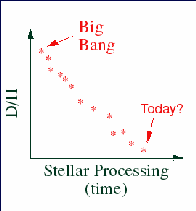

Presentation courtesy of William Blair, JHU.
A hydrogen atom has a single proton and a single electron. If one adds a neutron to the nucleus, the atom is still hydrogen, but the atom will have a different atomic weight. This is called an isotope of hydrogen. Other elements have isotopes, too, but hydrogen's isotope is so important that it has been given it's own name: deuterium. Deuterium is also known as "heavy hydrogen" because of the extra neutron in the atomic nucleus.
[Hydrogen has a third isotope called tritium, with a proton and two neutrons, but it radioactively decays in a short time and is unimportant for the observations described here.]
Interestingly, astronomers think that the only significant source of the deuterium isotope was the Big Bang itself. Big Bang nucleosynthesis models predict the relative amounts of the lightest elements and isotopes, which makes the relative amount of deuterium one of the key measurements needed for understanding the Big Bang.
But there are complications. Deuterium is a relatively fragile isotope, and the amount of deuterium has not stayed constant over time. In particular, when stars form out of gas, any deuterium in the star is just about the first thing to get destroyed. And so, over the history of the Universe, as material has been processed through stars, astronomers expect the relative amount of deuterium to decrease. Astronomers refer to this decrease in deuterium abundance as astration. In addition though, processing of gas through stars and back into the interstellar medium also changes the abundances of other elements such as oxygen, nitrogen, etc., so there is a way to test this idea. Understanding how much deuterium was created in the Big Bang and how much has been destroyed over time, are two of the Holy Grails of modern astrophysics.


Caption: (left) The graceful arcs of the Vela supernova remnant are seen against the rich star field of the Milky Way. This image shows material cast off from an exploded star after having been "processed" in the star's nuclear furnace. Such material has lower deuterium and higher heavy element abundance fractions. Over time, as shown at right, the cumulative effects are visible. (Image © Anglo-Australian Observatory.)
This is where FUSE and other telescopes enter the picture. The spectral fingerprints of deuterium are very prevalent in the FUSE spectral range, especially for objects in and near our galaxy (low redshift). However, the deuterium fingerprints are only slightly separated from those of normal hydrogen, and so one needs the high spectral resolution of FUSE in addition to the spectral coverage. FUSE has the right combination to tackle deuterium measurements in the local universe.
Caption: A small portion of the FUSE spectrum of the white dwarf star WD 1634-573.
Each panel shows the spectral region near a hydrogen absoprtion line. The blue regions
indicate the spectral fingerprint of deuterium (marked "D I"). The depth and shape
of these fingerprints compared to others such as oxygen and regular hydrogen, tells
astronomers the relative abundance of deuterium in the
gas being sampled on the sight line to the star. Note that the x-axis
has been converted from wavelength into a velocity scale.
(Graphic courtesy of JHU FUSE project.)
(Click on figure for enlarged version.)
But sampling deuterium abundances in the local universe is a tough job. Even with FUSE, the measurements are very difficult, and the analysis complicated. Furthermore, we can't just measure deuterium toward one or two stars and get "the answer" we are after. It requires a compilation of data for MANY sight lines to stars of differing distances from the sun. This guarantees that we sample a range of conditions and don't get tricked by looking at any single objects that may be peculiar. Even now, more than five years after launch, many new results are still being analyzed and published. We are still trying to get to the bottom line, but some very intriguing results are taking shape.
What has FUSE Found?
The ensemble of FUSE observations is showing several interesting results. First, by observing numerous stars in the region directly around the sun (within 100 parsecs or about 325 light years), FUSE observations have very strongly confirmed that the ratio of deuterium to hydrogen (D/H) is constant, at a value of about 15 parts per million (ppm) of D relative to H. Researchers have been working toward confirming this idea and quantifying the local value of D/H for decades! This important result means that this region, which is often referred to as the "Local Bubble," is chemically well-mixed and reasonably uniform.
Second, FUSE observations for stars at greater distances are finding a broad range of D/H ratios, some as high as about 25 ppm and some as low as only 7 ppm. The figure below summarizes this result graphically. This raises some very important questions that astronomers now need to address, such as: What is the cause of the observed variation in D/H ratio?", and What is the true local universe D/H ratio for comparison to astration models?"

Caption: The deuterium-to-hydrogen ratio is plotted versus distance (left) and versus the neutral hydrogen column density (right). A flat line fits the points on the left side of each panel, but then the points scatter (both up and down) for points in the middle region of each panel. There is some indication that the D/H ratio for the most distant sightlines sampled (at far right in each panel) are uniformly low, but this is still being stidied. (Graphic courtesy of Wood et al. (2004). Full reference below.)
As is so often the case in science, we start out asking one question, but by obtaining new state-of-the-art data, we get pointed in another direction and toward new questions. There are already groups testing both hypotheses, that (a) the higher values of D/H are the real local universe values, or (b) the lower values are more representative. The interesting thing is that confirming EITHER of these hypotheses will carry with it the need to answer further questions about the chemical history of our Galaxy and the universe in which we live.
Graphic credits:
Wood, B.E., Linsky, J.L., Hébrard, G., Williger, G.M., Moos, H.W., & Blair, W.P. 2004, The Astrophysical Journal, Vol. 609, 838-853 "Two New Low Galactic D/H Measurements from the Far Ultraviolet Spectroscopic Explorer"